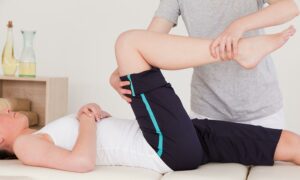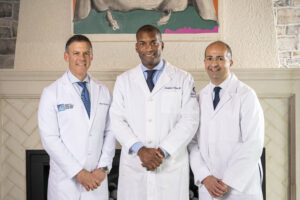Recovery time for ACL (anterior cruciate ligament) surgery can range from 4 to 8 months (or longer), depending on the surgical technique and severity of the injury. Learn what you can do in the meantime to speed up recovery.
Highlights
- 250,000 cases of ACL injury – the most common ligamentous injury – occur in the U.S. each year.11
- Orthopedic surgeons perform nearly 100,000 ACL surgeries each year.
- For most patients, rapid functional recovery occurs during the first 3 months after surgery.
- Because each injury is unique, it is best to apply patient-specific criteria for recovery and return-to-sport decisions.
Several Factors Affect Recovery Time for ACL Surgery
There are two broad categories to describe recovery from an ACL injury.
First, return to usual activities, such as walking without crutches, going back to school or work, and driving again. They are collectively known as functional milestones. Second, return to training or competitive sports activities. While a patient can achieve these milestones within weeks after ACL surgery, return to training or sport can take several months.
The factors affecting recovery time for ACL surgery include: 22
- Type of surgery. Allograft surgery allows patients to discontinue narcotic pain medication earlier. That said, the impact of surgical techniques on recovery time is debatable.
- Sex. Men are more likely than women to return to work/driving earlier.
- High age and low BMI. Both the factors correlate with early return to work.
- Biological response to surgery. In some patients, graft maturation can take more than 2 years.
- Knee alignment. Bowlegs can increase stress on the ACL.
- Motivation. Pre-surgery optimism may enhance recovery outcomes.
Return to Day-to-Day Activities After ACL Surgery
The average recovery period for regaining each functional milestone after ACL surgery is summarized below: 33
- Stopping the use of pain reliever – 9 days
- Discontinuation of crutches – 15 days
- Return to school – 7 days
- Return to work – 11 days
- Return to driving – 11 days
Some patients may need more than 30 days to discontinue crutches and return to moderate/heavy work.
Also Read: When ACL Surgery is the Right Decision – Maintaining a Patient’s Active Lifestyle
Return to Sport After ACL Surgery
An athlete’s decision to play again primarily depends on three factors – fear of a new injury, pain, and strength deficit.
Sadly, about 1 in 10 patients undergoing ACL surgery never resume sports activity, write the Italian traumatology researcher Albert Gobbi and colleagues. Likewise, 1 in 4 has a decreased level of activity, and 6 in 10 regain their pre-injury level of activity. 44
The average duration for return to sport after ACL surgery is: 52
- 4 to 6 months for returning to training.
- 6 to 8 months for returning to competitive sports.
- 186 days for soccer players to return to official matches.
Nonetheless, some experts recommend a gap of at least two years between ACL surgery and return to sport. This recommendation is based on the finding that young athletes (less than 20 years) are 3 to 6 times more likely to have a second injury following ACL surgery.65
What to Expect After ACL Surgery: The Timeline of Recovery
There is no one-size-fits-all protocol for post-surgery rehabilitation. Some surgeons may break down recovery into 3 phases, while some may follow the 5-phase rehabilitation. Regardless of the number of phases, all types of ACL rehabilitation have a common goal – to restore normal function within the shortest possible time.
ACL surgery is an outpatient procedure. Thus, your doctor will usually allow you to go home on the day of surgery. Continue reading to find out what to do after you reach home, when to call a doctor, and what to expect weeks or months after surgery. 76,7,8
Right after ACL surgery: Do’s and Don’ts
Treatment aims to relieve pain and swelling and prepare you for more advanced recovery phases. Pain and discomfort will continue for the first few days. So, you may take an OTC pain reliever, such as Advil (ibuprofen) or Tylenol (acetaminophen), or a prescription narcotic. Make sure you take any of these drugs only as your doctor advises.
A low-grade fever (98.7 to 100.4°F) can last 4 to 5 days and should improve with acetaminophen. However, if your fever persists or worsens, talk to your doctor.
Move your ankles regularly to improve circulation and prevent clots in your legs. If you experience pain in the calf, talk to your doctor immediately, as it could be due to a blood clot.
Avoid applying heat to the affected area.
First 2 weeks after ACL surgery: Do’s and Don’ts
Treatment aims to improve range of motion (ROM) with active and passive exercises.
Once your pain is in control, you should bend and straighten your knee as much as  possible with an aim to reach your pre-injury knee movement. Besides, you should work to strengthen the muscles that help your knees bend. These include quadriceps and hamstrings.
possible with an aim to reach your pre-injury knee movement. Besides, you should work to strengthen the muscles that help your knees bend. These include quadriceps and hamstrings.
Orthopedic surgeons and physical therapists generally recommend the following exercises:
- Knee extensions
- Static quads
- Heel slides
- Prone knee bend
- Active straight leg raise
Don’t walk without a brace, and avoid standing/walking for prolonged periods.
2 to 6 weeks after ACL surgery: Do’s and Don’ts
By this time, you should have discontinued crutches and regained your full range of motion. Treatment aims to improve knee stability and restore muscle strength, power, and speed.
Exercises used during phases can include:
- Double leg squats
- Step-ups
- Balance training
- Agility drills
- Plyometrics
- Hamstring stretches
- Calf raises
Don’t do any of these exercises if you have not regained your full range of motion.
6 to 12 weeks after ACL surgery: Do’s and Don’ts
This is the late phase of rehabilitation where you have gained sufficient joint mobility, muscle strength, and balance.
Your physical therapist customizes the exercises, depending on your goals and athletic demands, which may include:
- Specific strength training
- Power and agility drills
You may swim, cycle, or job, as advised by the physical therapist. Moreover, you will gradually resume your training.
Don’t do any of these exercises if the affected knee is swollen or has not regained full range of motion.
More than 3 months after ACL surgery: Do’s and Don’ts
Treatment aims to prepare you for resuming your sports activity (about 6 months after ACL surgery). Thus, exercises in the preceding phases are likely to continue and increase in intensity.
During this period, you should be able to run and jump in all directions. Moreover, your therapist will advise specific programs to reduce the risk of a second injury.
Don’t do any exercises if your knee is swollen or has not regained full range of motion.
3 Tips to Speed Up Your Recovery After ACL Surgery
Full recovery after ACL surgery may take several weeks or even months. That said, the following tips help you heal faster and achieve the best possible outcomes.
- Take your medicine: Take your medicine as prescribed to relieve pain and improve your performance while doing the rehabilitation exercises.
- Get enough sleep and nutrition: Sleep and nutrition are crucial to your recovery. Aim for at least 7 hours of sleep each night, and eat plenty of lean protein, dairy, fruits, and vegetables. Also Read: How Many Hours of Sleep Do Teens Need?
- Talk to your doctor: Talk to your doctor immediately if you have persistent fever, calf pain, or any other issues. Doing so will help you avoid complications.
Get a Telehealth Appointment or Second Opinion With a World-Renowned Orthopedic Doctor
 Telehealth appointments or Second Opinions with a top orthopedic doctor is a way to learn about what’s causing your pain and getting a treatment plan. SportsMD’s Telehealth and Second Opinion Service gives you the same level of orthopedic care provided to top professional athletes! All from the comfort of your home.. Learn more via SportsMD’s Telemedicine and Second Opinion Service.
Telehealth appointments or Second Opinions with a top orthopedic doctor is a way to learn about what’s causing your pain and getting a treatment plan. SportsMD’s Telehealth and Second Opinion Service gives you the same level of orthopedic care provided to top professional athletes! All from the comfort of your home.. Learn more via SportsMD’s Telemedicine and Second Opinion Service.
ACL Surgery: FAQs
Q: How many days after ACL surgery can I walk?
A. Walking with a crutch should be possible 1-2 days after ACL surgery and without crutches after 15 days. However, some may take up to one month before they can walk without a crutch.
Q. Should I wear braces after ACL surgery?
A. Wearing braces after ACL surgery helps reduce mobility, which stabilizes the affected knee and decreases stress on the ligament.
Q. How long will I be off work after ACL surgery?
A. If you sit at work, you will likely be able to go back within 2 weeks. But if you have to stand, it may take about 5 weeks. If your work demands moderate/heavy activity, you may need to wait up to 6 months.
12 weeks post ACL surgery💪🏼💯@RIV_PT_Emcee “ Recovery is a process. It takes time. It takes patience. It takes everything you’ve got.” pic.twitter.com/PMRauzXH3h
— Brooke Blumenfeld (@Brooke_blume) October 8, 2020
References
- Filbay, Stephanie R, and Hege Grindem. “Evidence-based recommendations for the management of anterior cruciate ligament (ACL) rupture.” Best practice & research. Clinical rheumatology vol. 33,1 (2019): 33-47. doi:10.1016/j.berh.2019.01.018.
- Zaffagnini, Stefano et al. “Return to sport after ACL reconstruction: how, when and why? A narrative review of current evidence.” Joints vol. 3,1 25-30. 8 Jun. 2015.
- Obermeier, Michael C et al. “Examination of Early Functional Recovery After ACL Reconstruction: Functional Milestone Achievement and Self-Reported Function.” Sports health vol. 10,4 (2018): 345-354. doi:10.1177/1941738118779762.
- Gobbi, A., Karnatzikos, G., & Lad, D. G. (2015). Factors Affecting Return to Sport After Anterior Cruciate Ligament Reconstruction. Sports Injuries, 1059–1066. doi:10.1007/978-3-642-36569-0_264.
- Nagelli, Christopher V, and Timothy E Hewett. “Should Return to Sport be Delayed Until 2 Years After Anterior Cruciate Ligament Reconstruction? Biological and Functional Considerations.” Sports medicine (Auckland, N.Z.) vol. 47,2 (2017): 221-232. doi:10.1007/s40279-016-0584-z.
- Cavanaugh, John T, and Matthew Powers. “ACL Rehabilitation Progression: Where Are We Now?.” Current reviews in musculoskeletal medicine vol. 10,3 (2017): 289-296. doi:10.1007/s12178-017-9426-3.
- Oxford University Hospitals NHS Trust. ACL Reconstruction Physiotherapy advice for patients. Accessed 29 August 2021.
- Filbay, Stephanie R, and Hege Grindem. “Evidence-based recommendations for the management of anterior cruciate ligament (ACL) rupture.” Best practice & research. Clinical rheumatology vol. 33,1 (2019): 33-47. doi:10.1016/j.berh.2019.01.018.
